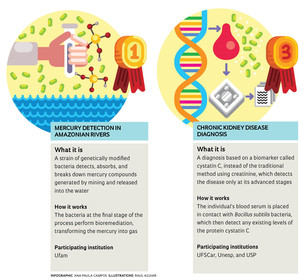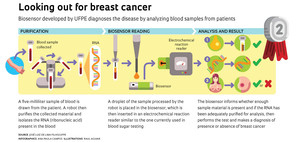
IGEM 2014
Researchers from universities around the world during iGEM 2014, the International Genetically Engineered Machines Competition, in Boston. Three Brazilian teams participated IGEM 2014Three research projects developed by students and professors from five Brazilian universities have won awards at the International Genetically Engineered Machine (iGEM) Competition, an event created by the Massachusetts Institute of Technology (MIT). Held in late 2014 in Boston, USA, iGEM 2014 featured 245 participating teams, totaling more than 2,300 students from higher education institutions around the world, including such prestigious American and British universities as Harvard, Yale, Stanford, MIT, Oxford, and Cambridge. The mission of the contest, created in 2004, is to encourage the advancement of research on synthetic biology, a field that focuses on the development of biological devices – including sensors, equipment, and software – designed to solve problems related to the environment, medicine, energy, and food.
The Brazilian teams won their space in the spotlight, presenting two medical biosensors: one for the diagnosis of breast cancer and the other designed to identify a specific marker of chronic kidney disease. Both devices use blood samples to achieve earlier diagnoses than can be obtained through the exams applied today. The third award-winning Brazilian project featured genetically modified bacteria that are programmed to detect and absorb mercury compounds that pollute rivers in the Amazon region. “It’s great to see the work developed in Brazil win recognition at a top-level international competition like iGEM. The award is very important as a stimulus for new generations of young researchers, and it reveals that teamwork is essential for achieving a successful result,“ says physician José Luiz de Lima Filho, scientific director of the Keizo Asami Immunopathology Laboratory (Lika) at the Federal University of Pernambuco (UFPE). Lima Filho is a member of the team that created a biosensor used for diagnosing early-stage breast cancer. “Our biosensor detects microRNA molecules produced by cancer cells before a tumoral process begins. This is its main advantage over the traditional technique most commonly used today, the mammogram, which can only identify the disease when a tumor measuring at least half a millimeter already exists,” he says. “The earlier a cancer is detected, the higher the chances of a cure.” Ribonucleic acid (RNA) is a polymer of nucleotides, responsible for protein synthesis in cells. MicroRNA are tiny strands of RNA, containing 20 nucleotides or so, found in plants and animals.
The new diagnostic machine, which won the silver medal in its category at iGEM, is part of the PhD thesis of Deborah Zanforlin, PhD student in the Applied Biology and Health program at UFPE. Researchers at the Recife Center for Advanced Studies and Systems (C.E.S.A.R) also participated in the project. The group developed a robot to prepare the blood samples collected from patients for subsequent analysis by the biosensor. The system is also equipped with a quality control device that evaluates whether the collected material is in proper condition to be analyzed accurately by the biosensor (see infographic).The researchers have already proven the effectiveness of the system’s concept and have completed laboratory tests using samples from cancer patients. The next step will be to build the first prototypes for clinical testing in the field. “When it becomes available on the market, our biosensor will not require specialized personnel to process the samples – unlike the molecular tests applied today for cancer diagnosis. It’s easy to transport, so the patient won’t have to visit a medical facility to perform the exam. They can do it right in the doctor’s office. It could be important for prevention, to help in diagnostics, and to treat breast cancer, helping to reduce the number of cases in Brazil,” says Lima Filho.
 The Brazilian project for biomarker-based diagnoses of chronic kidney disease (CKD) won a bronze medal at iGEM. The device was developed by students and professors from the University of São Paulo (USP), São Paulo State University (Unesp), and Federal University of São Carlos (UFSCar). Biomarkers are biochemical structures found in the human body. Altered levels of specific biomarkers may indicate the presence of a physiological abnormality or a disease.
The Brazilian project for biomarker-based diagnoses of chronic kidney disease (CKD) won a bronze medal at iGEM. The device was developed by students and professors from the University of São Paulo (USP), São Paulo State University (Unesp), and Federal University of São Carlos (UFSCar). Biomarkers are biochemical structures found in the human body. Altered levels of specific biomarkers may indicate the presence of a physiological abnormality or a disease.
Creatinine is the biomarker currently measured for diagnosing CKD. But there are problems with its use, as creatinine levels vary according to nutrition, age, and muscle mass. Also, it can only be used in diagnostics when the disease is already at an advanced stage. “The advantage of cystatin C, the biomarker we use in our project, is that its levels do not change with a person’s nutrition, age, or muscle mass, and it can also detect the disease at earlier stages,” explains Professor Francis de Morais Franco Nunes, from the Department of Genetics and Evolution at UFSCar.
Nunes says that the first step was to design a genetic circuit (a strand of selected genes) that would – at least in theory – be functional when introduced into a microorganism, executing a specific task. The chosen microorganism was the bacterium Bacillus subtilis. The design involves putting the individual’s blood serum in contact with the bacteria, which would detect the levels of cystatin C in the sample and distinguish between normal levels found in a healthy person and abnormal levels found in a CKD patient.
If all goes according to plan, the finished device will be about five square centimeters in size and will have interior chambers where all the necessary reagents will be contained. One of them will hold the bacterial spores and the other will be designed to induce the spores’ activation and the growth of the modified bacterial cells containing the genetic circuit. At the end of the detection process, a third chamber will be responsible for sterilizing the device and maintaining local biosafety.
 Development of the bacterial biodetector is still ongoing, with about 60% of the genetic circuit already complete, but the team has already obtained experimental proof of the concept that the bacterium can detect the presence of cystatin C in blood and quantify its concentrations. “We estimate that another four years are necessary to complete the project. Our expectation is that this technology will be accessible to everyone,” says Matheus Pedrino Gonçalves, biotechnology student at UFSCar and a member of the group.
Development of the bacterial biodetector is still ongoing, with about 60% of the genetic circuit already complete, but the team has already obtained experimental proof of the concept that the bacterium can detect the presence of cystatin C in blood and quantify its concentrations. “We estimate that another four years are necessary to complete the project. Our expectation is that this technology will be accessible to everyone,” says Matheus Pedrino Gonçalves, biotechnology student at UFSCar and a member of the group.
The third Brazilian research project to win an award at iGEM came from the laboratories at the Federal University of Amazonas (UFAM). The group, which won the gold medal in its category, created a strain of genetically modified bacteria that can detect, absorb, and break down mercury compounds present in water. Their plan is to use microorganisms – which qualify as genetically modified machines, according to the researchers – to rid the Amazon’s springs from the highly toxic heavy metal. River contamination by mercury in the region is due mainly to the metal’s use in gold mining. Spent mercury is released illegally into the environment.
“We inserted genetic circuits in laboratory-grown bacteria [Escherichia coli] and discovered, through laboratory testing, that they can degrade up to 70% of the mercury present in their culture medium,” says Carlos Gustavo Nunes da Silva, professor of Genetic Engineering at UFAM and coordinator of the project, which involved 15 students. The microorganisms were modified in three different, but complementary ways. One bacterium was genetically engineered to become a biosensor able to detect mercury in the environment – it turns fluorescent green when the metal is present. Another was altered to capture mercury from the water and thus perform the bioremediation process per se. And a third was programmed to convert the mercury present in the environment into mercury gas (Hg0). With the help of researchers from the university’s engineering and design departments, the team intends to create a system that will store the volatile mercury for later reuse – in the manufacture of lamps and electronics, for instance, or even for recycling the mercury in discarded electronics.
“Our inspiration for the project was a set of genes called operon mer, which some bacteria already have and use for metabolizing mercury. We studied how these genes work together to degrade mercury, and we selected the most interesting ones to build our genetic constructs for the bacteria,” explains Laís Almeida Gomes, one of the students involved in the project. According to Gomes, who has a master’s degree in Genetics, Conservation, and Evolutionary Biology from the National Institute for Amazonian Research (INPA), the project is at an advanced stage, but still needs a few adjustments.
Although all tested systems have shown that the bacteria respond positively to the presence of mercury, the researchers realized that the technology will need to be developed further for use at a larger scale. Building bioreactors for the treatment station will pose an additional challenge. This stage of the project is expected to be completed by September 2015. None of the modified bacteria is harmful to humans.
“The main advantage of our work is the possibility of removing mercury not just from rivers, but also from other environments, as many companies in the region use this substance in their processes and discard it inadequately,” says Gomes. This would be greatly beneficial to Amazonian society, which relies on rivers for fish, its main source of food. “The medal motivates us to keep working and to continually improve, and this will help more people believe in scientific development in the region.”
Republish